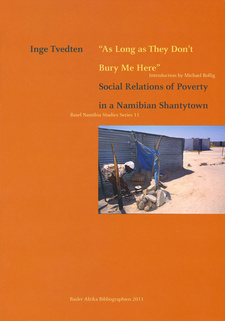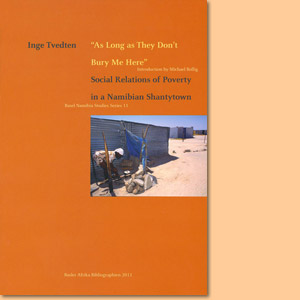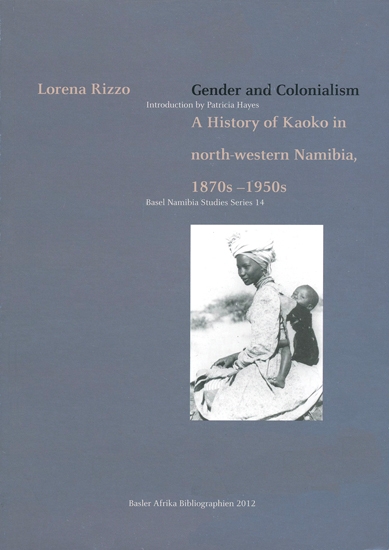As Long as They Don’t Bury Me Here: Social Relations of Poverty in a Namibian Shantytown, by Inge Tvedten.

As Long as They Don’t Bury Me Here: Social Relations of Poverty in a Namibian Shantytown, by Inge Tvedten. ISBN 9783905758245 / ISBN 978-3-905758-24-5
Dr Inge Tvedten's study, As Long as They Don’t Bury Me Here: Social Relations of Poverty in a Namibian Shantytown, not only offers a detailed and well-grounded account of the origins and contemporary faces of urban African poverty and marginality: it provides a theoretical and meaningful framework through which to view the actors, their fates, their ideas and their activities in great detail.
Telling their story over many years: An introduction
Social science studies on urban settings in southern Africa remain rare. This holds especially true for social anthropology as a discipline and for Namibia as a region. Much of the ethnography published over the past two decades - there has been a lot of ethnographic production on Namibia in the recent past - has focused inter alia on rural communities, identity politics, the politics of remembrance and on state-local community interactions. Despite an often publicised concern about growing poverty, both in rural and urban areas and rapidly growing cities (33 per cent of all Namibians live in an urban setting, the growth rate of urban centres is 5.6 per cent and urban poverty increasingly shapes urban landscapes), there is only a very limited number of anthropological and sociological studies on impoverished urban communities. There are various reasons for this omission. On the one hand, social science research on urban squatter communities is exceedingly difficult both from a methodological and a humanitarian point of view and, on the other, many anthropological theories favoured over the last decade do not seem to offer a convincing perspective for an understanding of the situation of urban shanty town dwellers: neither do they play the harp of identity politics, nor are they (usually) portrayed as strategy-conscious actors optimising certain resources. Inge Tvedten's book deals with urban poverty in a northern Namibian shanty town: its causes, its national as well as its global ramifications and the strategies employed by the poor to cope with their situation. Unlike other southern African cities that evolved along trade routes, Oshakati was founded mainly for military purposes by the colonial South African government. The town's importance grew during South Africa's war with SWAPO in Angola becoming a major basis for army operations. Soldiers - many of them of Angolan descent - moved their families and relatives to the town. After 1990, Oshakati became an important hub in the trading network between Namibia and Angola. Since the early 1990s, Tvedten has worked in the shanties of Oshakati, which continue to grow rapidly. Repeated visits over the years brought him into regular contact with a number of his informants, thus enabling him to tell their story over many years. Initially submitted in 2008 as a PhD to the University of Cape Town, one of the book's great strengths is that it links the structural aspects of oppression and marginalisation to local agency Tvedten's long exposure to the social dynamics of households and the fate of individuals helps him to overcome a problem that social anthropological fieldwork frequently confronts: based as it is on field studies of a year or so, it becomes difficult to predict the direction in which a certain situation is developing. Tvedten's intimate description of live histories brings the actors to life and, in this way, demonstrates the impressive scope of their agency. Shanty town dwellers and their households form highly heterogeneous units. Household structures differ at any given moment both in and over time. The rapid increase of female-headed households is of great importance, as is the isolation of very poor males. Using extensive documentation, the author details how poverty has, unsurprisingly, become feminised during the past decades. [...]
This is an excerpt from the book: As Long as They Don’t Bury Me Here: Social Relations of Poverty in a Namibian Shantytown, by Inge Tvedten.
Title: “As Long as They Don’t Bury Me Here”
Subtitle: Social Relations of Poverty in a Namibian Shantytown
Author: Inge Tvedten
Series: Basel Namibia Studies Series 11
Publisher: Basler Afrika Bibliographien
Basel, 2011
ISBN 9783905758245 / ISBN 978-3-905758-24-5
Softcover, 17x24 cm, 216 pages, images, maps, tables, index
Tvedten, Inge im Namibiana-Buchangebot
As Long as They Don’t Bury Me Here: Social Relations of Poverty in a Namibian Shantytown
The study As Long as They Don’t Bury Me Here analyses social relations of poverty in the Oshakati shantytown, Namibia.
Weitere Buchempfehlungen
Fotografische Erinnerungen an Deutsch-Südwestafrika, Band 3
Fotografische Erinnerungen an Deutsch-Südwestafrika Band 3: Der 1. Weltkrieg in Deutsch-Südwestafrika.
Gender and Colonialism: A History of Kaoko in North-Western Namibia 1870s-1950s
Gender and Colonialism: A History of Kaoko in North-Western Namibia 1870s-1950s is an attempt to convey a multi-faceted history of a region that has only recently been tied into a national historiography.
Naming the Land. San Identity and Community Conservation in Namibia’s West Caprivi
Naming the Land is a study about San Identity and Community Conservation in Namibia’s West Caprivi.
The Rise and Fall of Apartheid
This is an authorative, balanced and lucid history of the rise and fall of Apartheid in South Africa.





